10 Adapted Fine Motor Activities for Children with Increased Tone in their Hands
Fine motor skills – which involve the coordination of the small muscles in the hands and fingers with the eyes – are essential to undertake a number of daily living activities. For example, our children need fine motor skills to feed themselves, play with toys and communicate their needs by using their hands or pointing.
To develop good fine motor skills, our child needs good core stability (see our section on core stability) and strength in their shoulders, arms and hands (see our section on arm strengthening for ideas). Without strength further up the body, the hand will not have a stable base to work from and our child will find it much harder to develop their fine motor skills.
If our child doesn’t have good core stability, it is best to practice their fine motor activities in supportive seating – with any harness or supports in use. This will replace core stability to enable them to be as successful and enjoy the activity as much as possible.
Below we share ten great activities to help develop fine motor skills at home.

Before trying these exercises, take a minute to prepare your child – they will feel the benefit!
To wake up their muscles, squeeze their hands, tips of their fingers and their arms. You could also use a brush along their skin, or a vibrating massager. All of these will increase your child’s awareness of their body, helping them be more accurate and learn more effectively. It will also increase their enjoyment of the activity.
You may want to give their hand, wrist and arm a stretch first to allow them to have the most movement possible with which to play.
Make sure your child is successful in their game as this will motivate them to continue. As you push them to get to the next level, they should be able to manage a few of their attempts to stay motivated – even if they are not successful every time.
Remember to praise the effort made rather than the result achieved. This motivates a child to keep putting in effort and not be put off if they don’t succeed.
10 Fine Motor Skills Activities
Start with big toys – soft toys are good as your child may be able to grasp these more easily than hard objects.
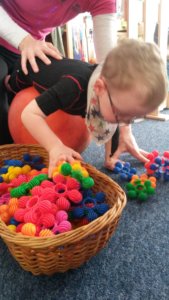 Help your child open their hand to get a good amount of toy into their hand to grasp. If they hold their hand in a tight fist, bend their wrist forward towards the palm side as this will release their muscles and open their hand.
Help your child open their hand to get a good amount of toy into their hand to grasp. If they hold their hand in a tight fist, bend their wrist forward towards the palm side as this will release their muscles and open their hand. If your child needs help to keep the grasp, use your hand over their hand to help them so they get the feeling of what you are doing. Brushing your hand, quickly, a few times across the back of their wrist can often help prompt their hand to open and let go.
You can also bend their wrist the other way to help them make a fist. Encourage them to drop the toy into a container – again helping them by bending their wrist forwards towards their palm if they are really struggling.
Move onto trickier items such as play cars or plastic animals. Encourage your child to open their hand first before trying to pick up the items to give themselves their own active stretch.
If your child understands the concept of sorting, you may want to include some sorting in this game. Encourage your child to sort items by colour or type. It may be that sorting means pushing an item off their tray into a container, or just moving the items to one side. If your child is able to use their fingers to move the objects rather than pushing with their hand in a fist then even better. The key with this activity is to try to encourage lots of grasping and releasing.
For an alternative sorting game, print photographs of the toys or objects you want your child to move. Arrange the photos to the side of your child, and ask them to move the real life object over to the matching photo.
Pretend play can be a nice way to make grasping and releasing more meaningful. Play a shopping game with your child, asking them to choose items from their tray or table to put in a shopping basket.
Once your child can comfortably manage medium size objects, try sorting smaller items such as pasta, coins or (if they’re ready) even smaller items like smarties, or mixed dried foods like beans, rice, lentils and chick peas. You can dye dried food prior to play to make the game more engaging (see our section on messy play to find details of how to dye different foods). To add a further challenge, try giving your child a pair of tweezers for this task – or encourage them to use their less dominant hand.
Once your child has sorted their small objects, you can suggest an additional activity using the items they’ve sorted. For example, they could make a necklace out of the tube pasta, or make a picture using glue and the dried food items. This will keep your child motivated to keep sorting and is another great way to work their fine motor skills.
You can add further challenge by creating a Laser Quest game in a box. See our video for more information.
Turn-taking games that involve throwing dice can be a great way to practice fine motor skills with family and friends (we love Orchard Toys for fun board games). There are large dice available to buy online or you could re-purpose a building block if this is easier for your child.
Drawing can be practiced with a hand, finger or with an implement.
Start your child drawing with their fingers or hands. This could be during messy play (e.g. in sand or shaving foam) or using a tablet. To show them the way, you could draw a line for them to copy or follow in the path you have made.
Move on to trying drawing with implements. Large pieces of chalk or crayons need less fine motor skills than smaller implements. To begin with any grip is fine, as holding the grasp as well as keeping pressure can be a great challenge in itself.
To begin with, encourage any kind of mark making on the page or on a chalk board. As their skills develop, encourage them to draw lines: up and down, side to side or diagonal. Curved lines are more complicated, with circles being the most tricky drawing movement.
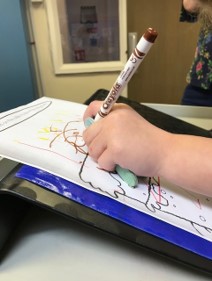 Here’s a helpful tip to help your child hold a drawing implement: take a regular clothes peg and clip it round the end of the pen. If this looks comfortable to them, your child can now be helped to hold across the peg and with their index finger around the other side of the pen.
Here’s a helpful tip to help your child hold a drawing implement: take a regular clothes peg and clip it round the end of the pen. If this looks comfortable to them, your child can now be helped to hold across the peg and with their index finger around the other side of the pen. It’s also usually easier to make marks on an angled surface. You can rest or stick paper onto a lever arch file, or prop a board onto something to tilt it. Ikea have inexpensive laptop supports that work really well for this.
As your child improves, move on to thinner crayons or pens.
Music is a motivating way to improve fine motor skills, and there are lots of options depending on skill level.
Your child can use their hand to hit a keyboard or a drum as an easy way to get some cause and effect feedback without needing high levels of fine motor skill.
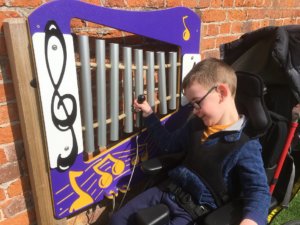
The next stage of difficulty is to use a hand-held implement to make music. Holding a stick to hit a drum or using a rattle or tambourine is a good way to practice grasping.
Fine motor skills can further be refined by just using the index (pointing) finger to make music, while holding the rest of the fingers in. Practice pressing a keyboard key with this finger, pressing buttons on musical toys or using the pointing finger for music games on a tablet.
If you don’t have any instruments at home you can make your own using objects in the home. A wooden spoon and upside down saucepan can become a drum and drumstick, a plastic bottle with some rice in it becomes a shaker. This blog offers some other easy ways to make musical instruments from everyday objects.
Playing with stickers is a great way to practice fine motor skills.
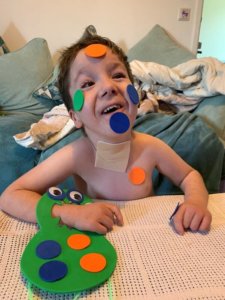 Peeling stickers off their backing uses as much (if not more!) skill as sticking them down
Peeling stickers off their backing uses as much (if not more!) skill as sticking them down You can sticking easier by peeling most of the sticker off its back. Your child can use their fingers to take the rest off and then stick to a piece of paper or part of their body.
Try using stickers to ‘colour in’ a shape – or draw a shape with the stickers. You could always give stickers as a reward for great effort or behaviour – they won’t even know they are still working!
Start with putting soft toys or rolling large balls into an open container. Use brightly coloured containers such as bright pink stain remover tub, or items with metal bases to give “noisy” feedback e.g. hot choc tub or Pringles tube.
Progress to smaller toys into a smaller container. You could combine this with a matching game, like putting the red objects into the red container.
Shape sorter games are fantastic for working fine motor skills. If you don’t have a shape sorter, cut a circular hole in the lid of a plastic pot and post small objects.
As your child gets more accurate, cut smaller circles or slits and post smaller objects such as coins, pebbles or buttons. You could cut different sizes of slits for different sizes of objects so they have to work out sizes as they post.
Start with threading pipe cleaner through the holes of a colander. Your child could make lines across to make a bridge for their cars.
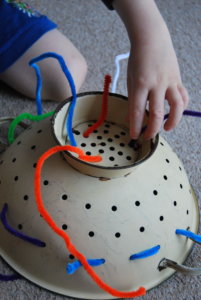 Or keep to the side of the colander and just go freestyle and make some lovely patterns.
Or keep to the side of the colander and just go freestyle and make some lovely patterns.You could also stick a piece of uncooked spaghetti in some play-dough or blue tack on the table so it is sticking right up. Your child could then thread tube pasta onto the spaghetti.
As their skills improve, use laces (with the taped end) to thread paper. Use a hole punch to make holes along the edge of a piece of card. Or try making necklaces with the laces and tube pasta.
As they improve, use string, or ribbon or even some thread on a needle for threading games. They could add colour to a basket by adding ribbon through the holes, have fun re-lacing the shoes in your house or cut some straws into small tubes to lace into a necklace.
Start with simple paper weaving. Cut some coloured paper into 1 inch strips. Cut a different piece of paper into 1 inch slits but leave an inch uncut at the end so the paper is still attached at the top. Your child can then slip 1 loose strip over and under the main paper. Start nearest to the end which is still in one piece. The next piece goes over and under (the opposite from the first strip).
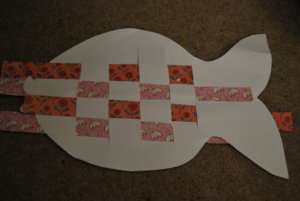
You could try this with smaller strips of paper to make it more difficult.
Move on to weaving knitting wool. This video shows how you can weave just using a piece of cardboard.
https://www.youtube.com/watch?v=QW2zwr6txdo&feature=youtu.beMove onto shapes. This video shows how to make cool patterns on a paper plate but you could use any cardboard you have (old cereal boxes etc) instead. You could even write out your child’s name.
Here is a lovely video which shows how to make a simple Pom Pom. This is a lovely exercise to use repetitive use of your child’s hands to strengthen and improve their endurance.
Knitting is a great progression to weaving and brilliant for developing those more advanced fine motor skills. Finger knitting is straight forward and a good way to start and you only need some wool to try it. This video gives a lovely demonstration.
Puzzles are lovely for making children match up shapes. Some children will try to use force instead of turning the puzzle piece to make it fit, so start with easy puzzles where they can be more successful to teach them about turning the puzzle piece (or turning the board if they can’t turn their hand as well).
Puzzles with pegs on them are often the best place to start if children don’t have full fine motor control.
Place stickers underneath the items so that taking out the pieces also gives a reward in the early stages – you could have a “treasure” hunt game.

Move onto regular flat puzzles as skills improve.
Use smaller pieces as skills improve.
If you don’t have puzzles at home, find a pretty page from a magazine and cut it into teo or three pieces (as a start). Your child can piece the pieces back together.
Building towers requires a steady hand and precision in placement of the next block.
Start with bigger objects to stack, such as cushions and pillows, books or empty cans. This works well as a 2 handed activity. They will also get a lovely stretch of their arms as they reach higher in the stack.
As they get more accurate, try smaller stacking items such as chunky Lego or blocks.
As they get more accurate, try smaller stacking such as coins, lego, or blocks. They can build all sorts of scenes and structures with building toys and piecing the pieces together which is great for their fine motor skills.
Another great thing with this game is that they then get to knock it all down.
Consider using giant coloured lolly sticks to build on a flat surface- they are available from craft stores. Adding dabs of velcro can work well to help them stick together to make shapes.
If you have some sticky velcro – try adding dabs to blocks to help them stick.
Magnetic building and design sets are available online- you can use the lid of a biscuit tin to create shapes and scenes – a child with limited grasp and release skills can often push pieces around.
We also love the commercially available magnetic shapes – different colours and shapes to make designs on a flat metal surface (e.g. fridge door?) or to build up.
If you don’t have play-dough there are plenty of different ways to make dough at home. See our videos for how to make dough and how to play with it if you have less refined fine motor skills.
Make the dough with your child for an extra opportunity to strengthen hands and fingers.
Kneading the dough, rolling it with a rolling pin, squashing dough balls, squeezing it through their fingers, pushing items into the dough – with a full hand or with a pointing finger are all great ways to work your child’s fine motor and hand skills.
You can also put different objects into dough or other soft play mixtures – things they need to find or things to play with e.g. cars or plastic animals/ dinosaurs/ figurines.
Hiding marbles in your play-dough will work their manipulation skills brilliantly.
This video gives ideas of how to strengthen fingers and work fine motor skills.






